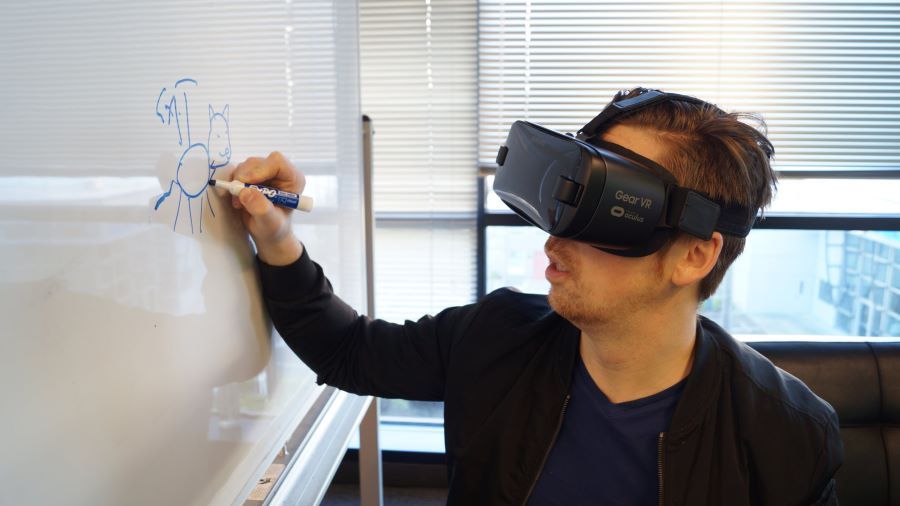Virtual reality has made its contribution by significantly altering the world of entertainment and endowing people with new fascinating experiences. Given its high demand, social response, success, and the impact it has on people, the introduction of virtual reality into education was inevitable. Indeed, today, one of the most popular areas of development and application of virtual and augmented reality is the education industry. The approaches to use advanced technologies in such a sphere are abundant – from ordinary tours of Ancient Rome in geography classes to the preparation of specialists to work on a "bullet" train or even the cosmic station.
Nowadays, learners attending all existing educational establishments are engulfed by a whole host of information channels, bringing them pillars of new knowledge to absorb every day. Students also find it hard to adjust to their busy lifestyles, as well as to cope with a large number of educational tasks. That is why so many college – and university-goers resort to the custom writing help resource essayservice.com to ask certified authors to assist them with their academic assignments. Global education has reached a point in its elaboration where specific changes need to be made to enhance students' overall learning experience and make it more engaging and exciting. Virtual reality is the best tool for such a mission. It can appeal to various types of learners – visual, auditory, and kinesthetic – and offer all of them equal opportunities for achieving academic success.
Benefits of the Use of Virtual Reality in Education
A realm of new prospects in studying and education brought by the application of virtual reality is too complicated, money- or time-consuming with traditional approaches, if not all at once. There are five primary advantages of using augmented-reality technologies academically.
Demonstrativeness
With the help of 3D graphics, it is possible to display in detail all chemical processes, down to the atomic level. Furthermore, nothing stops educators from going deeper and showing the process of nuclear fission inside the atom before a nuclear blast happens. It implies that augmented reality can provide general information about the phenomenon and also explicitly demonstrate it.
Safety
Controlling the space shuttle, performing heart surgery, driving a super-fast train, exploring fire safety precautions – augmented reality allows to immerse the viewer in any of these occasions without any threat to their lives.
Engagement
Virtual reality lets tutors and coaches change work plans, influence the progress of an experiment, or solve a mathematical problem in a playful and understandable way. During the virtual lesson, learners have the chance to see the world of the past through the eyes of any historical character, go on a journey through the human organism in a microcapsule, or tour the Titanic.
Focusing
The augmented reality, which will surround the students from all sides, providing a 360-degree view, will allow them to focus on the studied material and not be distracted by external stimuli.
Virtual Reality Formats in Education
The use of cutting-edge technologies in education implies that the academic process must be restructured accordingly.
Full-Time Education
VR technologies offer exciting opportunities for transmitting empirical material. In this case, the classic learning format is not distorted, since each lesson is supplemented by a 5-7-minute immersion. Lecturers can use a scenario in which the virtual class is divided into several scenes that are enabled at the right time of the learning session. As before, the lecture remains the structure-forming element of the lesson. Such a format lets educators modernize the educational process, involve students in it, clearly illustrate and absorb the training material.
Remote Education
In distance learning, a student, as well as a tutor, can be located anywhere in the world. Each of the participants of the academic process is given their own avatar and is present in the VR classroom. That is, they listen to lectures, interact with each other, and even conduct group assignments. It gives learners a sense of presence and eliminates the boundaries that exist when studying through videoconferencing. The teacher will also be able to understand when the student decides to leave the classroom since the Oculus Rift and HTC Vive helmets are equipped with a light sensor allowing them to recognize whether the helmet is currently being used or not.
Mixed Education
If there are circumstances that prevent students from attending classes, they can do so remotely. The classroom must be equipped with a camera for shooting video in a 360-degree format with the ability to broadcast it in real-time. Learners who take the classes remotely will be able to observe what is happening in the classroom from a first-person perspective (for example, directly from their seats), see their classmates, communicate with the professor, and participate in joint lessons.
Self-Education
Any of the developed educational courses available at academic institutions can be adapted for self-study. Thus, the lessons can be placed in online stores (for instance, Steam, Oculus Store, App Store, and Google Play Market) so that everyone has the opportunity to master the material or to refresh their memory on it themselves.
How Virtual Reality Is Used In Colleges/Universities
While still pursuing a degree at college or university, students start pondering their dream careers. At this stage of their education, they possess writing and communication skills of impressive quality and level, helping them to grasp elaborate concepts. In this case, augmented reality may assist them in staying ahead of the technology curve. Thus, some universities have already implemented VR technologies in their teaching process.
As for learners specializing in different scientific fields, e.g., medical science, augmented-reality education can help med students experience close to real-life cases in a virtual world where they can understand situations better and find solutions much faster. In the sphere of art and media, learners can investigate their creativity using virtual reality through immersive 360-degree photography and videography. It is also fascinating that university and college attendees can take virtual tours of the campuses of their dream tertiary education institutions.








